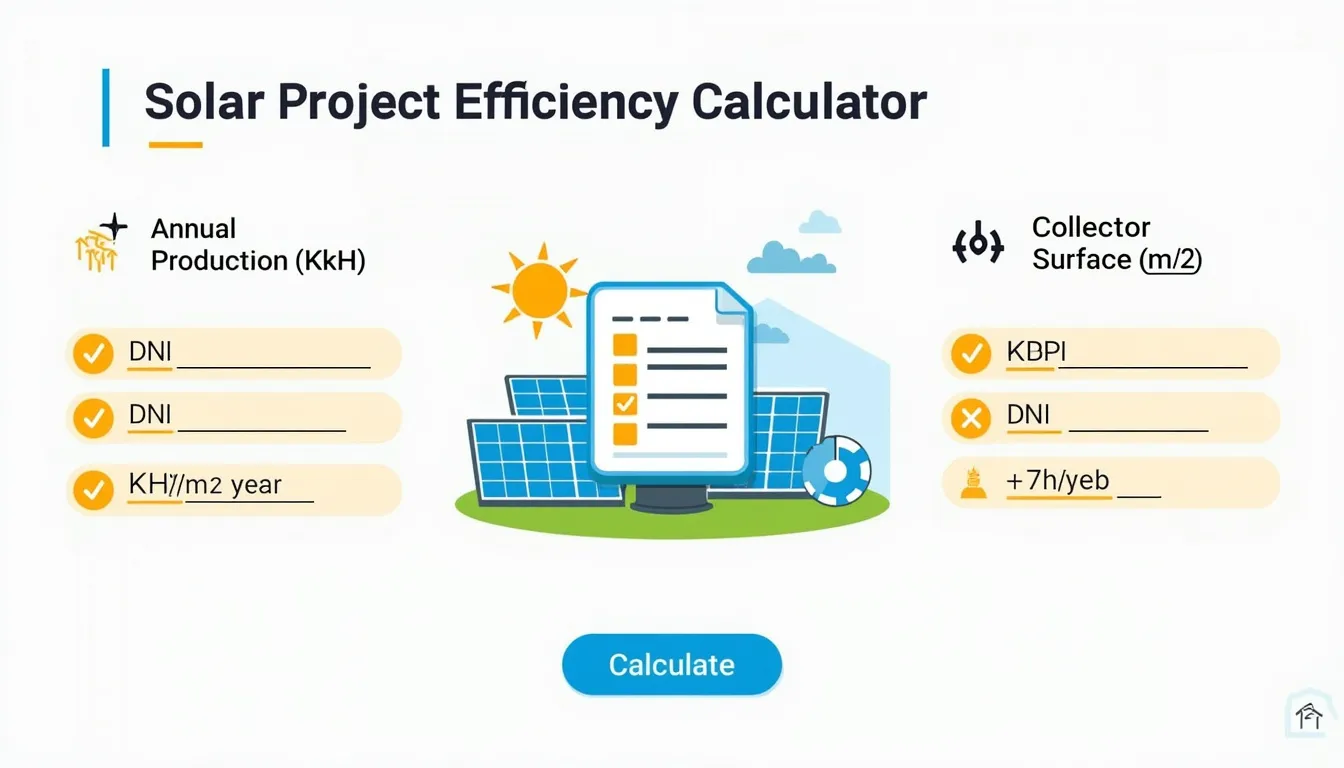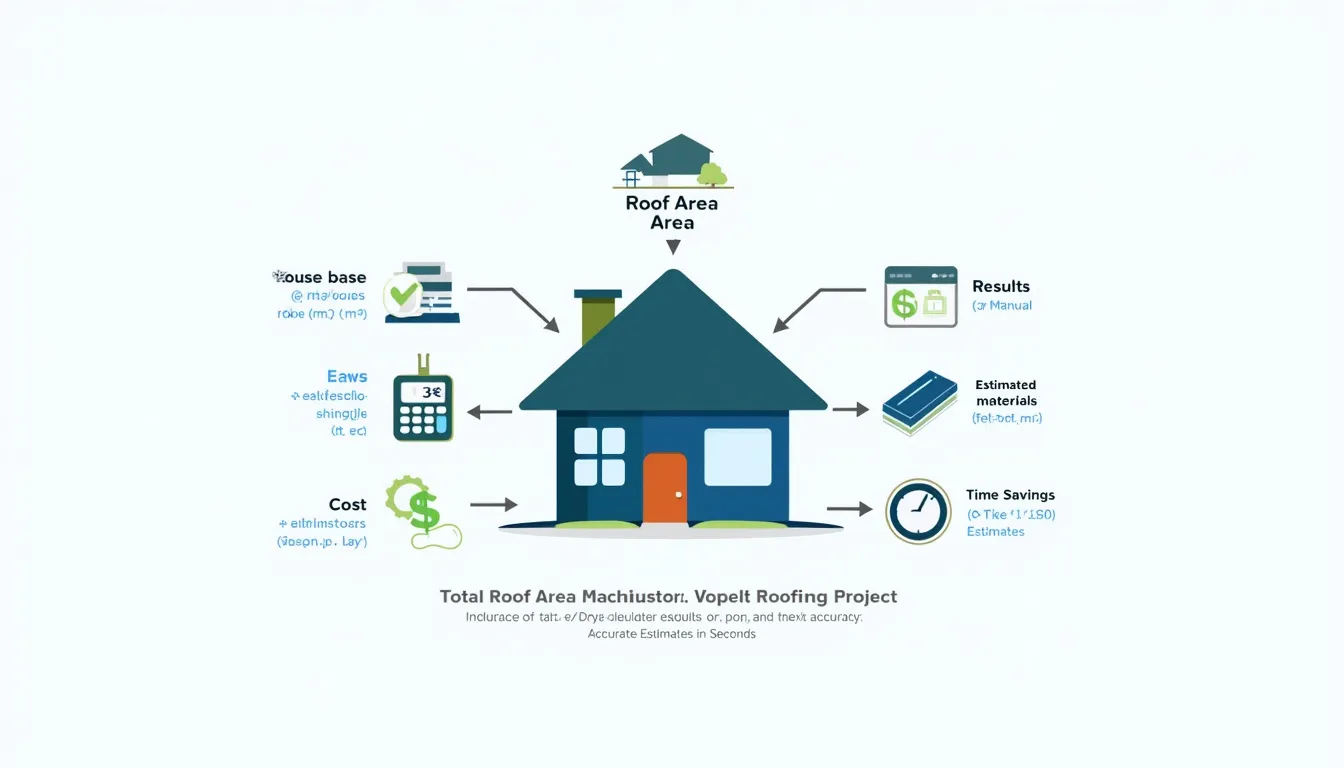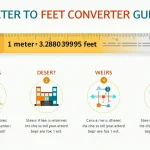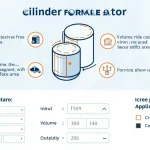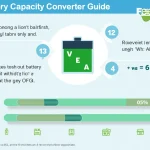Project Efficiency Calculator
Is this tool helpful?
How to Use the Project Efficiency Calculator Effectively
Maximize your solar energy system’s performance by following these simple steps to accurately calculate your project’s efficiency. Inputting precise data into each field ensures reliable and actionable results.
- Enter Annual Production (kWh): Provide the total energy your solar system generates annually in kilowatt-hours. (Example: 12,500 kWh or 6,300 kWh)
- Input Collector Surface Area (m²): Specify the combined surface area of your solar collectors in square meters. (Example: 60 m² or 85 m²)
- Enter Direct Normal Irradiance (DNI) (kWh/m²/year): Provide the annual solar irradiance value reflecting the sunlight intensity per square meter at your installation site. (Example: 1,700 kWh/m²/year or 2,100 kWh/m²/year)
- Calculate Efficiency: Submit your data to instantly receive your project’s efficiency percentage, enabling you to assess the overall system performance.
Introducing the Project Efficiency Calculator: Definition, Purpose, and Benefits
The Project Efficiency Calculator is an essential web-based tool crafted to help solar energy professionals, engineers, researchers, and enthusiasts evaluate and optimize the performance of their solar energy systems. By analyzing key parameters such as annual energy output, collector surface area, and local solar irradiance, this calculator reveals the actual efficiency at which your solar project converts sunlight into usable electrical energy.
Understanding and monitoring project efficiency provides numerous benefits:
- Accurate Performance Metrics: Quickly quantify how well your solar system utilizes available solar energy.
- Informed Optimization: Identify design shortcomings or operational inefficiencies and make data-driven improvements.
- Benchmarking: Compare your installation’s efficiency with industry standards or similar projects in your region.
- Financial Insight: Evaluate the economic viability of your solar investment through efficiency trends.
- Environmental Contribution: Assess how effectively your project supports renewable energy goals and reduces carbon emissions.
Example Calculations Using the Project Efficiency Calculator
Understanding the calculation behind your efficiency percentage helps you interpret results meaningfully. The project efficiency represents the ratio of your system’s actual energy output to the theoretical solar energy incident on your collector surface, expressed as a percentage.
The formula applied by the calculator is:
$$ \text{Project Efficiency} (\%) = \frac{\text{Annual Production (kWh)}}{\text{Collector Surface Area (m}^2) \times \text{DNI (kWh/m}^2\text{/year)}} \times 100 $$Sample Calculation 1: Medium-Sized Residential Installation
- Annual Production: 9,000 kWh
- Collector Surface Area: 75 m²
- DNI: 1,850 kWh/m²/year
Using the formula:
$$ \frac{9,000}{75 \times 1,850} \times 100 = \frac{9,000}{138,750} \times 100 \approx 6.49\% $$This means the solar system converts about 6.49% of the available solar irradiance into usable electrical energy.
Sample Calculation 2: Commercial Solar Roof Project
- Annual Production: 45,000 kWh
- Collector Surface Area: 210 m²
- DNI: 2,100 kWh/m²/year
Applying the formula:
$$ \frac{45,000}{210 \times 2,100} \times 100 = \frac{45,000}{441,000} \times 100 \approx 10.20\% $$This indicates an efficient system converting over 10% of the available solar energy into electricity, which is considered a solid project efficiency value for commercial solar setups.
Why Use This Solar Project Efficiency Calculator?
This calculator is specifically designed to provide insights into your solar energy system’s real-world performance, helping you to:
- Accelerate Performance Analysis: Save time and effort by automating complex calculations.
- Enhance System Design and Deployment: Make informed decisions on collector sizes and site selection.
- Support Project Management: Monitor efficiency trends to schedule maintenance proactively.
- Make Strategic Investment Decisions: Evaluate expected returns based on realistic efficiency metrics.
- Compare Site Viability: Incorporate DNI data for site feasibility studies considering varying solar irradiance.
Target Audience and Use Cases
Our Project Efficiency Calculator caters to a diverse range of users involved in solar energy:
Solar Energy Professionals
Engineers and system designers who need precise efficiency metrics for refining system configurations and improving overall solar project output.
Residential and Commercial Installers
Installers assessing installation success and setting performance benchmarks tailored to specific projects and environments.
Project Developers and Investors
Stakeholders evaluating project feasibility and profitability by comparing solar resource data with actual energy production.
Researchers and Educators
Academic and research professionals leveraging the tool for studies related to solar energy efficiency, sustainability, and technology advancement.
Summary: Empower Your Solar Energy Decisions with Accurate Efficiency Metrics
The Project Efficiency Calculator stands out as an intuitive and practical solution for anyone seeking to understand and optimize solar energy system performance. By synthesizing annual production, collector surface area, and site-specific irradiance data, it provides a clear and actionable efficiency percentage tailored to your solar project.
Regularly using this tool enables you to:
- Track solar project health and performance over time
- Identify underperforming installations early
- Make evidence-based system adjustments and upgrades
- Support environmental sustainability through better resource utilization
- Enhance financial planning and investment strategy with reliable data
Start leveraging the power of the Project Efficiency Calculator today to maximize the value and impact of your solar energy systems with confidence and precision.
Important Disclaimer
The calculations, results, and content provided by our tools are not guaranteed to be accurate, complete, or reliable. Users are responsible for verifying and interpreting the results. Our content and tools may contain errors, biases, or inconsistencies. Do not enter personal data, sensitive information, or personally identifiable information in our web forms or tools. Such data entry violates our terms of service and may result in unauthorized disclosure to third parties. We reserve the right to save inputs and outputs from our tools for the purposes of error debugging, bias identification, and performance improvement. External companies providing AI models used in our tools may also save and process data in accordance with their own policies. By using our tools, you consent to this data collection and processing. We reserve the right to limit the usage of our tools based on current usability factors.
